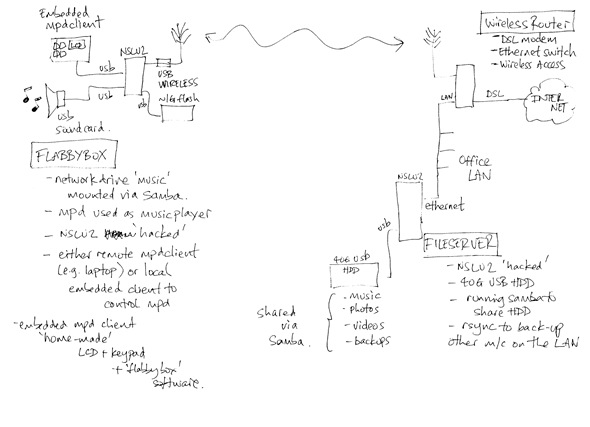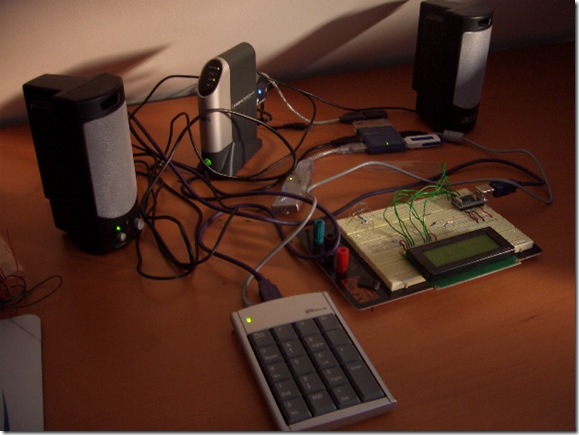My first attmpt to reflash the NSLU2 with Debian Etch using the Debian Installer repeatedly failed while downloading packages from the mirrors (Next time I try it I'll make more detailed notes of what went wrong!) - so instead I used the manual method described here. This uses a tar ball prepared by Martin Michlmayr which just needs to be unpacked into the target filesystem.
Firstly, I partitioned the usb diskdrive. I plugged the drive into my laptop running Ubuntu 7.04 and used fdisk to create the required partitions. In order to match Martin's tar ball, I created /dev/sdb1 for the root partition (size 3000M), /dev/sdb2 as an extended partition from which I created /dev/sdb5 for the swap partition (700M) and /dev/sdb6 for the home partition (the remainder of the disk ~ 36G) are created. I also used fdisk to make /dev/sdb1 bootable and to change the type of /dev/sdb5 to 82 (Linux swap).
(...I had to reboot the laptop and then unmount the automounted usb disk before the next step...)
I then formatted the drive –
mkfs.ext3 /dev/sdb1
mkfs.ext3 /dev/sdb6
mkswap /dev/sdb5
- and mounted it on the laptop -
sudo mount /dev/sdb1 /mnt/tmp
I got the tar ball from -
wget http://people.debian.org/~tbm/nslu2/etch/base.tar.bz
- and unpacked it onto the root partition of the prepared drive -
cd /mnt/tmp
bzcat ~/base.tar.bz2 tar -xvf -
I then had to manually install the proprietary firmware that is needed for the in-built Ethernet chip, following the instructions on the NSLU2-Linux wiki describing how to extract this firmware from an installer image, as follows -
Firstly I downloaded the debian-installer image from slug-firmware.net and unpacked the image using slugimage (the version of slugimage packaged for Ubuntu was too old - I got my version from the Unslung CVS.)
slugimage -u -i di-nslu2.bin
- endian swapped the initramfs (ramdisk.gz).
devio '<< ramdisk.gz; xp $ 4' > ramdisk-swap.gz
- unpacked the initramfs
mkdir initrd; cd initrd
zcat ../ramdisk-swap.gz cpio -i
(there were lots of errors here relating to file permissions - but the firmware seems to have been extracted OK)
The NPE microcode firmware was in the initrd/lib/firmware directory - called NPE-B.01000201. I copied this file to /mnt/tmp/lib/firmware, and then created a symbolic link in /mnt/tmp/lib/firmware called NPE-B which points to NPE-B.01000201.
sudo cp NPE-B.01000201 /mnt/tmp/lib/firmware/
cd /mnt/tmp/lib/firmware; sudo ln -s NPE-B.01000201 NPE-B
The filesystem was now prepared, so I put the NSLU2 in upgrade mode and flashed the etch firmware image using upslug2 (the version packaged with Ubuntu was OK).
sudo upslug2 -i sda1-2.6.18.dfsg.1-12.bin
I connected the hard drive when upslug2 had finished and the NSLU2 rebooted the new Debian system. The system obtained an IP address via DHCP on eth0. I was able connect via SSH with user root and password root.
First thing I did was changed the root password -
passwd root
- regenerated the ssh keys
ssh-keygen -f /etc/ssh/ssh_host_key -N '' -t rsa1
ssh-keygen -f /etc/ssh/ssh_host_rsa_key -N '' -t rsa
ssh-keygen -f /etc/ssh/ssh_host_dsa_key -N '' -t dsa
- edited /etc/network/interfaces to give a static IP address
# This file describes the network interfaces available on your system
# and how to activate them. For more information, see interfaces(5).
# The loopback network interface
auto lo
iface lo inet loopback
# The primary network interface
allow-hotplug eth0
iface eth0 inet static
address 192.168.1.77
netmask 255.255.255.0
gateway 192.168.1.1
- added a normal user andrew
adduser andrew
- changed the host name by changing 'foobar' to 'fileserver' in /etc/hostname and /etc/hosts
I then rebooted to make sure I could still log in (I could as user andrew and as root ...) then edited /etc/apt/sources.list to point to local mirrors as well as the contrib and non-free repositories -
deb http://ftp.uk.debian.org/debian/ etch main contrib non-free
deb-src http://ftp.uk.debian.org/debian/ etch main contrib non-free
deb http://security.debian.org/ etch/updates main contrib non-free
deb-src http://security.debian.org/ etch/updates main contrib non-free
and upgraded -
apt-get update
apt-get dist-upgrade
There was a kernel upgrade required, but no packages required updating.
Next - installing samba ...





